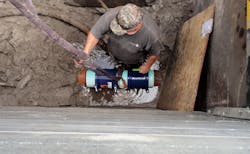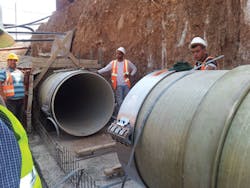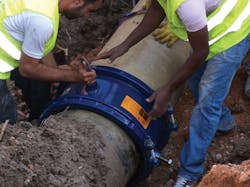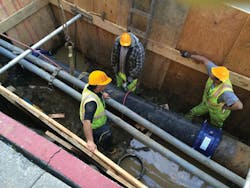Fix it? Or Nix it?
By Doug Riseden
Municipalities and water utilities in the U.S. are struggling to make upgrades due to budgetary restraints, even as their water and wastewater infrastructure is deteriorating. In the meantime, utilities make pipe repairs until a long-term solution can be financed and implemented. The question of when it makes the most financial sense to replace pipe versus repair it is not a simple one to answer. The short term costs of repairing pipe may seem like an attractive option to keep costs low but at a certain point, repeated repairs aren’t economical.
So, when does it make sense to repair pipe rather than to replace it? And when replacement is the answer, what can be done to ensure it’s done properly and the project is kept on time and on budget?
There are three major items to consider when thinking about whether to repair or replace pipe.
Cost: At a certain point, the costs involved in making repeated repairs outweigh the costs to replace the pipe. This includes the cost of parts and expenses involved in closing up the work area once the repair is completed. If utility crews are repeatedly visiting the same section of pipe, this is the first clue that the pipe may need to be replaced. While a repair can solve a problem in the short term, there could be higher costs and service interruptions in the long term.
Complaints: The reality is that customers often dictate when and what kind of response a utility will take when water or wastewater problems arise in their neighborhood. If service to homes and businesses is not reliable, customers are going to expect a solution that is dependable and minimizes interruption of their service.
Data: It’s never too late to start gathering data. Develop a system where information can be stored and easily recalled, as data is only as good as its accessibility. In the absence of data from the field, residences and businesses in the neighborhood may be able to help give information on the history of water and wastewater pipe repairs in the area. Without useful data, it’s impossible to make an informed choice that could involve hundreds of thousands of dollars. By keeping good records, carefully examining repair data and noticing trends, water utilities can make sound decisions about whether to repair or replace pipe.
Whenever repairs are being made, ask yourself these six questions to help gather information for future decisions on pipe repair or replacement: who, what, when, where, why and how?
Who was making the repair? Who was there, and who did what?
What was the issue? What actions were taken to make the repair?
When was the repair made? Be accurate with day, date and time.
Where was the repair? How many times have crews been to this same location or close by?
Why is the pipe breaking? Was the break due to a one-time incident, such as a gas company boring into the ground and hitting the pipe, or is the cause the same each time? Factors to consider include external forces such as ground movement, trains or heavy traffic.
How was the repair made? What parts and equipment were used to make the repair? How much did they cost? Were quality parts and good repair techniques used to fix the pipe?
When answers to these questions are recorded each time a repair is made, trends can be detected and it becomes possible to predict how likely it is that future repairs will be needed.
Pipe Installation Done Right
After reviewing the data and the costs involved, utilities can determine whether to move forward with replacing the pipe. Here are steps to ensure that new pipe installations are done properly while keeping the project on schedule and on budget.
Form a strong construction committee. To ensure that the installation goes smoothly, you need to have a committee of people who can supervise and review the project from beginning to end. Include the following people:
- at least one council member (this person is critical to communicating updates to the rest of council)
- the municipality’s finance officer
- the utility’s lead engineer and his/her assistant
- the public works director and his/her assistant
- the project inspector (who might be supplied by the engineer)
- a customer
Bringing together the right people at the beginning of the project is especially critical so that everyone is on board with the plan. Follow up meetings should also occur whenever there is a change to the plan, and it’s also a good idea to use email, Skype and other communication tools to keep everyone in the loop. Remember to be in contact with media and local officials, such as police, so the general public can be aware of what is happening before and during construction.
Stay in close contact with public works, engineers and inspectors. Public works or your utility should be the lead on your project since their crews will be tasked with maintaining the finished product. Ensure that they review the site and physically go out and walk around it. They should take photos and video before construction starts to help manage claims that could come up later. This activity should continue along with daily written reports, especially when changes are made to the original plan.
Speak and consult with engineers as often as needed. You will want to have your inspector closely monitoring the project - this is someone who knows the rules and regulations regarding installations and will help ensure the project gets approved upon completion.
Choose good products and work with responsible contractors. Your utility will likely have specs on what you will accept and use in different situations. Make sure these products have a great work history with the backing of other local professionals and your engineer.
It pays to use high-quality products that are exceptionally durable, even in harsh conditions, and designed to prevent future pipe damage. For example, Krausz products, such as the HYMAX, allow for repairs to maintain a flexible connection to prevent damage from post-installation ground shifts and temperature changes, protecting your investment over the long term.
Remember, there’s a difference between the lowest responsible bidder and the lowest bidder. The lowest bidder will sometimes leave things out of the bid and come back with a change order - which can dramatically increase the budget. When it comes to using the right contractor and parts, do your homework and get references to avoid surprises.
Have a realistic schedule. Make sure that your work schedule is fair to all of those involved. Customers will expect a project that adheres to a schedule that has the least effect on them. Your contractor will want a tight schedule so they can continue to their next job and avoid penalties for not meeting the scheduled completion date. Be realistic and stay in close communication with all those involved in the project, especially when plans change during construction.
If all goes well, there should be no surprises. Contractors and engineers should walk away happy, and the utility and customers should have a well done project.
Determining whether to repair or replace pipe is not an easy decision to make. It requires recording and analyzing data and costs, and close communication between customers, engineers, contractors, inspectors and the utility. It’s hard work but the long-term benefit of reliable service will last for decades.
About the Author: Doug Riseden is a technical support manager with Krausz USA.
More WaterWorld Current Issue Articles
More WaterWorld Archives Issue Articles




